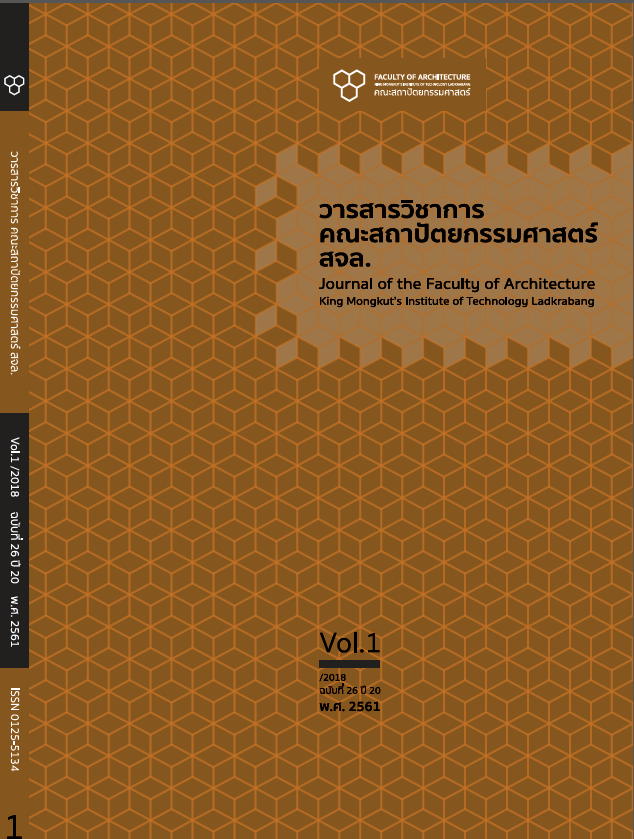อิทธิพลรูปแบบที่นั่งห้องเรียนต่อการเรียนรู้ของเด็กเรียนรู้ช้า, The Influence of Classroom Seating Arrangement on Student with Slow Learning
Main Article Content
บทคัดย่อ
บทคัดย่อ
การวิจัยเพื่อหารูปแบบที่นั่ง ที่ส่งผลต่อพฤติกรรมการแสดงออกของเด็ก โดยศึกษาลักษณะของเด็กที่มีการเรียนรู้ช้า โดยการสำรวจสภาพแวดล้อมภายในโรงเรียนบ้านหินลาด ใช้การสังเกตการณ์แบบไม่มีส่วนร่วม กับเด็กเรียนรู้ช้า 15 คน
ชั้นประถมศึกษาปีที่ 4 และ ปีที่ 5 ขณะทำกิจกรรมการเรียนรู้เพื่อลดความบกพร่องทางการอ่านและการเขียน ในวิชาภาษาไทย พบว่าจากการจัดที่นั่งเรียน 4 แบบ มี 2 พฤติกรรมที่ขัดขวางสมาธิ จำนวนเฉลี่ยของพฤติกรรมเกิดมากที่สุดในการนั่ง
แบบที่ 1 และแบบที่ 3 ซึ่งเห็นทางสัญจรทั้งสองรูปแบบ จากด้านหน้าและด้านข้างของที่นั่ง การนั่งแบบ ที่ 2 และแบบที่ 4 เป็นแบบเห็นทางสัญจรรูปแบบเดียว แบบหันข้าง สรุปได้ว่าควรให้เด็กนั่งในตำแหน่งที่เอื้อให้เกิดการมองเห็นการสัญจร
น้อยที่สุดเพื่อช่วยให้เด็กเกิดความต่อเนื่องในการเรียน
คำสำคัญ: การเรียนรู้ช้า รูปแบบที่นั่ง ห้องเรียน
Article Details
This work is licensed under a Creative Commons Attribution-NonCommercial-ShareAlike 4.0 International License.
Copyright Transfer Statement
The copyright of this article is transferred to Journal of The Faculty of Architecture King Mongkut's Institute of Technology Ladkrabang with effect if and when the article is accepted for publication. The copyright transfer covers the exclusive right to reproduce and distribute the article, including reprints, translations, photographic reproductions, electronic form (offline, online) or any other reproductions of similar nature.
The author warrants that this contribution is original and that he/she has full power to make this grant. The author signs for and accepts responsibility for releasing this material on behalf of any and all co-authors.
เอกสารอ้างอิง
นิพัทธา น้อยประวัติ. (2558). แบบจำลองสภาพแวดล้อมที่ส่งผลต่อพัฒนาการของเด็ก กรณีศึกษาการออกแบบสภาพแวดล้อม ที่เอื้อต่อกิจกรรมพัฒนาการของเด็กออทิสติก. (ปร.ด. สหวิทยาการ การวิจัยเพื่อการออกแบบ
(หลักสูตรนานาชาติ), สถาบันเทคโนโลยีพระจอมเกล้าเจ้าคุณทหารลาดกระบัง).
พระราชบัญญัติการศึกษาแห่งชาติ พุทธศักราช 2542. (2542, 14 สิงหาคม). ราชกิจจานุเบกษา. เล่ม 116 ตอนที่. 74 ก หน้า 1-28.
ผดุง อารยะวิญญู. 2546 วิธีสอนเด็กเรียนยาก กรุงเทพฯ: แว่นแก้ว.
อารียา สตารัตน์. (2456) การจัดสภาพแวดล้อมในสถานศึกษา ของโรงเรียนสังกัดกรุงเทพมหานคร สำนักงานเขตราชเทวี. (กศม. การบริหารการศึกษา, มหาวิทยาลัยศรีนครินทรวิโรฒ).
อุมาพร ตรังคสมบัติ. 2545 ช่วยลูกออทิสติก: คู่มือสำหรับพ่อแม่ผู้ไม่ยอมแพ้. กรุงเทพฯ: ศูนย์วิจัยและพัฒนาครอบครัว 2545.
Beaver, C. (2010). Autism-friendly environments, The autism file. 2010 (34), 82-85.
Conroy, M. A., Sutherland, K. S., Snyder, A. L., Marsh, S. (2008). Classwide interventions: Effective instruction makes a difference. TEACHING Exceptional Children. 40(6), 24-30.
Khare, R. and Mullick, A. (2008). Educational spaces for children with autism: design development process, In CIB W 084 International Meeting ‘Education And Training” Georgia Tech University. L. Biocca and
A. Morin (Eds.). Building Comfortable and Liveable Environment for All. (pp. 66–75). Atla. CNR ITC.
Conroy, M. A., Asmus, J. M., Boyd, B. A., Ladwig, C. N., and Sellers, J. A. (2007). Antecedent Classroom Factors and Disruptive Behaviors of Children with Autism Spectrum Disorders. Journal of Early Intervention.
30(1), 19-35.
Scott, I. (2009). Designing learning spaces for children on the autism spectrum, Good Autism Practice. 10(1), 36-51.
Vogel, C. L. (2008). Classroom design for living and learning with autism. University of Wisconsin-Madison Design Studies. Retrieved from http://www.designshare.com/index.php/articles/classroom_autism/


